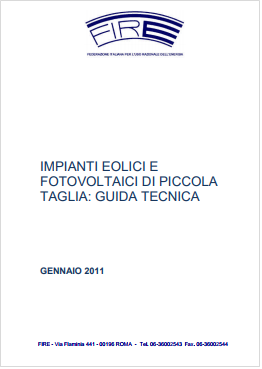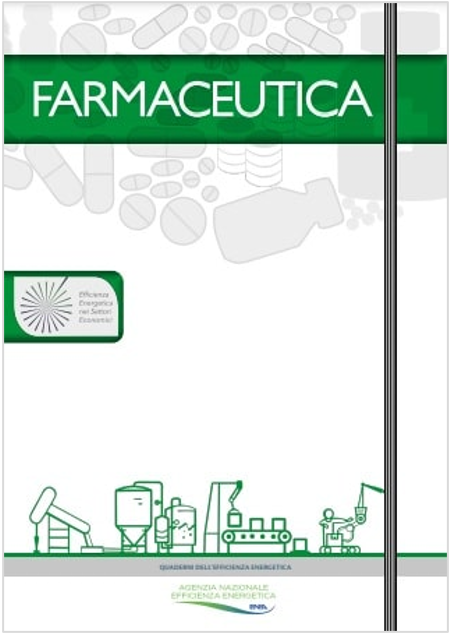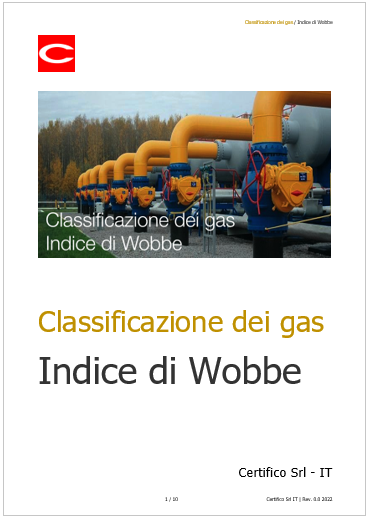
Classificazione dei gas / Indice di Wobbe
ID 5738 | 05.11.2022
Classificazione dei gas combustibili in accordo con il D.M. 16/04/2008 e la norma UNI EN 437:2021. Illustrazione Indice di Wobbe.
Indice di Wobbe
La norma UNI EN 437:2021 classifica i gas secondo l'indice di Wobbe, rapporto tra il potere calorifico di un gas per unità di volume e la radice quadrata della sua densità relativa nelle stesse condizioni di riferimento. L'indice di Wobbe è espresso in megajoule per metro cubo (MJ/m3) di gas secco nelle condizioni di riferimento (SI).
L'Indice di Wobbe, Iw, è definito come:

- ΔcHso è il potere calorifico superiore, o semplicemente valore calorifico
- ρ è la densità specifica del gas relativa a quella dell'aria.
L'Indice di Wobbe è usato per confrontare il potere calorifico di differenti miscele combustibili. Se due gas hanno lo stesso Indice di Wobbe significa che a parità di pressione di alimentazione l'energia trasportata sarà la stessa.
...
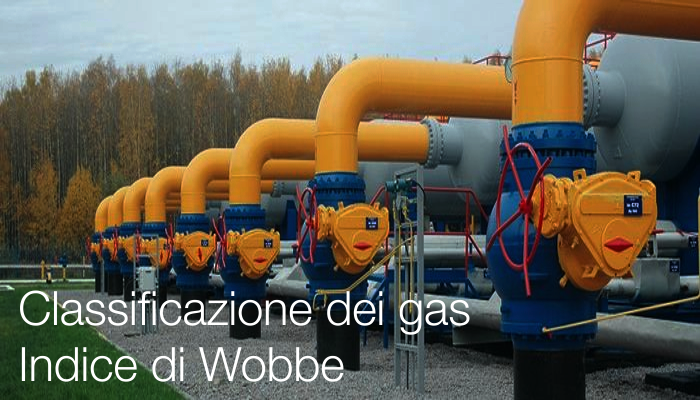
Il gas naturale ha una composizione diversa, a seconda della provenienza, per cui il potere calorifico e quindi anche l'indice di Wobbe possono differire abbastanza fortemente. ad esempio:
- il gas naturale Olandese (Groningen) ha un indice di Wobbe di 43,46 - 44,41 MJ/m3;
- il gas naturale Norvegese (Ekofisk) ha un indice di Wobbe compreso tra 48 e 53 MJ/m3.
Per approfodimenti:
UNI EN ISO 6976:2017
Gas naturale - Calcolo del potere calorifico, della densità, della densità relativa e dell'indice di Wobbe, partendo dalla composizione.
UNI EN ISO 15971:2014
Gas naturale - Misurazione delle proprietà - Potere calorifico e indice Wobbe
Indice di Wobbe (MJ/Nm3) di alcuni gas combustibili (esemplificativo / letteratura):
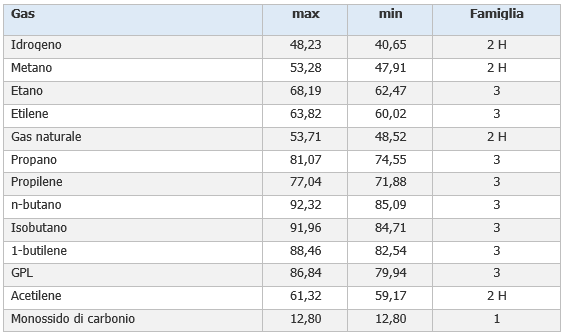
_________
Il D.M. 16/04/2008 classifica le condotte che alimentano e che si dipartono a valle degli impiantì di riduzione della pressione si classificano in (in relazione alla pressione):
Condotte di 1a Specie: condotta con pressione massima di esercizio superiore a 24 bar
Condotte di 2a Specie: condotta con pressione massima di esercizio superiore a 12 bar ed inferiore od uguale a 24 bar.
Condotte di 3a Specie: condotta con pressione massima di esercizio superiore a 5 bar ed inferiore od uguale a 12 bar.
Condotte di 4a Specie: condotta con pressione massima di esercizio superiore a 1,5 bar ed inferiore od uguale a 5 bar.
Condotte di 5a Specie: condotta con pressione massima di esercizio superiore a 0,5 bar ed inferiore od uguale a 1,5 bar.
Condotte di 6a Specie: condotta con pressione massima di esercizio superiore a 0,04 bar ed inferiore od uguale a 0,5 bar.
Condotte di 7a Specie: condotta con pressione massima di esercizio inferiore od uguale a 0,04 bar.
______
La UNI EN 437:2021 suddivide i gas combustibili in 3 famiglie e relativi sottogruppi, in sintesi:
I famiglia: gas manifatturati (gas di città)
- Group A
II famiglia: gas naturale (gas metano)
- Group H
- Group L
- Group E
III famiglia: gas di petrolio liquefatto (GPL)
- Group B/P
- Group P
- Group B
Classificazione dei gas adottata ai fini della loro intercambiabilità / Indice di Wobbe.
I Famiglia: Gas manifatturati. Gas di fossile o da idrocarburi definiti da un indice di Wobbe compreso tra 22,4 e 24,8 MJ/m3. A questa famiglia appartengono anche le miscele gas naturale/aria e GPL/aria con indice di Wobbe coerente.
II Famiglia: Gas naturale con indice di Wobbe compreso tra 39,1 e 54,7 MJ/m3. A questa famiglia appartengono anche le mischele GPL/aria con indice di Wobbe coerente.
III Famiglia: GPL (comprendono essenzialmente propano, butani e propilene) con indice di Wobbe compreso tra 72,9 e 87,3 MJ/m3.
UNI EN 437:2021
UNI EN 437:2021 Gas di prova - Pressioni di prova - Categorie di apparecchi
Recepisce: EN 437:2021
Data entrata in vigore: 13 maggio 2021
La norma specifica i gas di prova, le pressioni di prova e le categorie di apparecchi relativamente all'utilizzo di gas combustibili della prima, seconda e terza famiglia. Essa costituisce un documento di riferimento per le norme specifiche relative agli apparecchi.
La norma fornisce raccomandazioni sull'utilizzo dei gas e delle pressioni da applicare nelle prove degli apparecchi che utilizzano gas combustibili
Tuttavia l'utilizzo di alcuni gas e pressioni di prova potrebbero non essere appropriati nei casi seguenti:
- Apparecchi con portata termica nominale superiore a 300 kW
- Apparecchi costruiti in loco
- Apparecchi per i quali il progetto finale è influenzato dall'utilizzatore
- Apparecchi costruiti per essere utilizzati con alte pressioni di alimentazione (in particolare con l'uso diretto della tensione di vapore saturo)
In questi casi, le pertinenti norme di prodotto potrebbero specificare altre condizioni di prova al fine di dimostrare la conformità ai requisiti in esse definiti.
UNI EN 437:2021
3.10 reference conditions
conditions which correspond to 15 °C, 1013,25 mbar, unless otherwise specified
3.11 relative density d
ratio of the masses of equal volumes of dry gas and dry air under the same conditions of temperature and pressure: 15 °C or 0°C and 1013,25 mbar
3.1.2 calorific value
quantity of heat produced by the complete combustion, at a constant pressure equal to 1013,25 mbar, of a unit volume or mass of gas, the constituents of the combustible mixture being taken at reference conditions and the products of combustion being brought back to the same conditions
Note 1 to entry:
A distinction is made between:
- the gross calorific value Hs: the water produced by combustion is assumed to be condensed;
- the net calorific value Hi: the water produced by combustion is assumed to bein the vapour state.
Note 2 to entry:
The calorific value is expressed:
- either in megajoules per cubic metre (MJ/m3) of dry gas under the reference conditions; or in megajoules per kilogram (MJ/kg) of dry gas.
3.13 Wobbe index
ratio of the calorific value of a gas per unit volume and the square root of its relative density under the same reference conditions
Note 1 to entry:
The Wobbe index is expressed in megajoules per cubic metre (MJ/m3) of dry gas under the reference conditions.
Note 2 to entry:
The Wobbe index is said to be gross (Ws) or net (Wi) according to whether the calorific value used is the gross or net calorific value.
...
3.18 gas family
group of gaseous fuels with similar burning behaviour linked togeth er by a range of Wobbe indices
Note 1
to entry: See Table 1.
3.19 gas group
specified range of Wobbe index within that of the family concerned
Note 1 to entry:
This range is determined on the general principle that appliances using this gas group operate safely when burning all gases within this range without ad just ment.
Note 2 to entry:
Adjustment of the appliance may be permitted in accordance with the special national or local conditions that apply in some countries (see B.4). For gases corresponding to national or local conditions, see Tables B.5, B.6 and B.7.
Note 3 to entry: See Table 1.
...
4. Gases
4.1 Classification in gas families and groups
Gases are classified int o three families, each family may be divided into groups, (themselves being divided into ranges, see Annex B), as a function of the Wobbe index, according to the values given in Table 1.
NOTE 1
See Annex D for more details.
NOTE 2
The classification given in Table 1 is used for the communication of the types of gases and corresponding supply pressures of gaseous fuels used on the territories of Member States.
Table 1 - Classification of gas families and groups as a function of the Wobbe indices, dry gas at 15 °C and 1 013,25 mbar
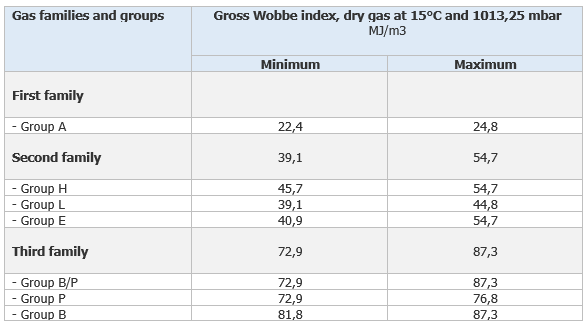
Def.
Ws - Wobbe index gross (according calorific gross calorific value)
Wi - Wobbe index net (according net calorific value)
Hs - gross calorific value
Hi - gross calorific net
d - relative density
Table 2 - Characteristics of the test gases (a) for the first and second families, gas dray at 15 °C and 1013,2 5 mbar
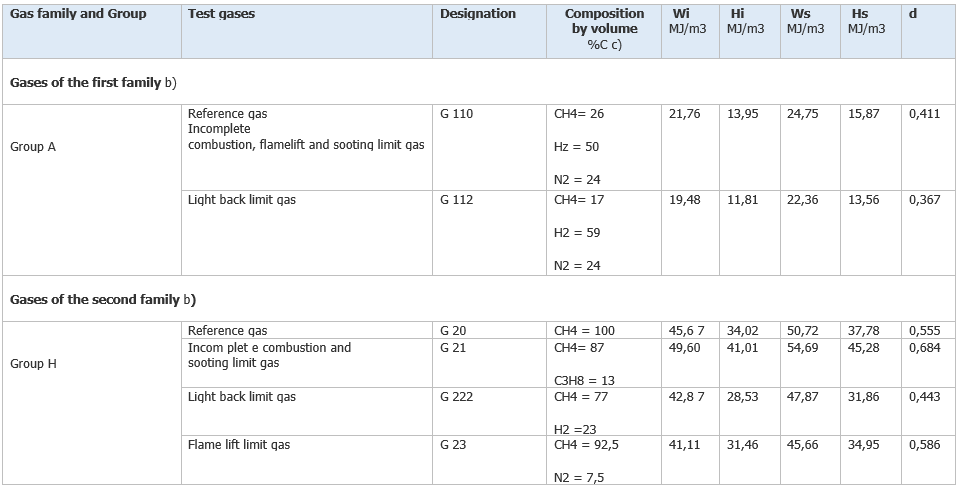
...
Table 3 - Characteristics of the test gases (a) for the third family, gas dry at 15 °C and 1013,25 mbar
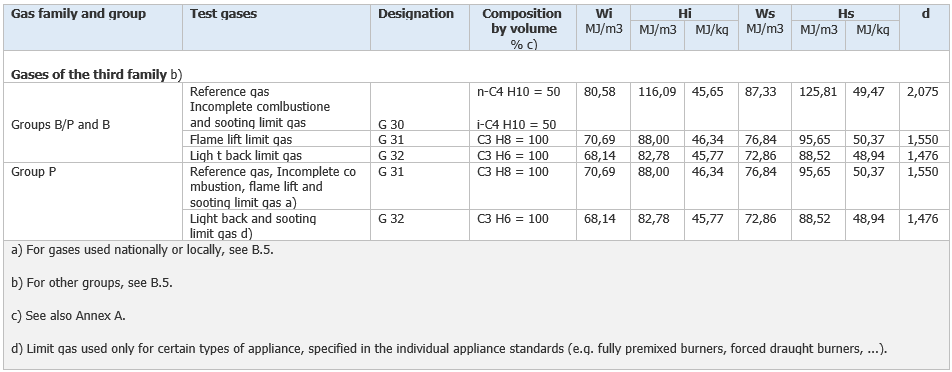
Table 4 - Characteristics of tbe reference gases of the second family at 0°C and 1013,25 mbar

...
Relationship between the distributed gases and the corresponding test gases
Distributed gases are classified in families and groups according to their Wobbe Index range.
The Wobbe index varies depending on the composition. Wobbe Index is the key combustion parameter but it is not the onlyone:flame velocity, combustion potential for flame appliances, soot index,incomplete combustion index and methane number for internal combustion engines.
The test gases whose composition is specified for a given gas group are determined so that tests carried outwith these gases according to the requirements given in the appliance standards enable to ensure the safe operation of the appliances.
These tests are carried out to the appropriate pressure depending on the type of test to be performed. Tests are carried out using two kinds of gases:
- The reference gas, chosen as to be representative of the gas group. It is the gas with which appliances operate under nominal conditions when they are supplied at the corresponding normal pressure. The appliance is generally factory set for this gas.
- The limit gases. They are chosen to help prevent the various kinds of malfunctioning:
- - Incomplete combustion,
- - Light back,
- - Lift,
- - Sooting,
and only for certain types of appliances (specified in the appliance standards), overheating.
They are representative of the extreme variations in the characteristics of the gases or operating conditions for which appliances have been designed.
The tests with limit gases are carried out with the appliance set using the corresponding reference gas.
The tests with limit gases are of short duration, and do not imply a satisfactory functioning when faced with a continual supply of distributed gases with a Wobbe index close to the maximum or to the minimum Wobbe index of the gas group.
...
segue in allegato
Certifico Srl - IT | Rev. 0.0 2022
©Copia autorizzata Abbonati
Collegati:
Allegati
|
Descrizione |
Lingua |
Dimensioni |
Downloads |
 |
|
IT |
242 kB |
155 |
